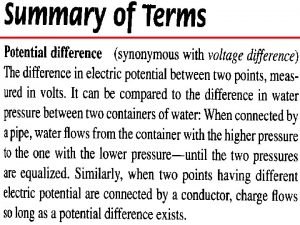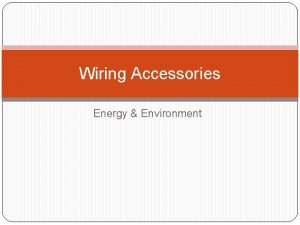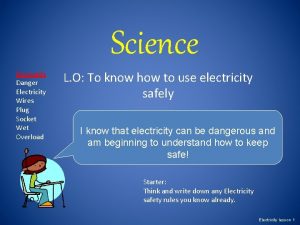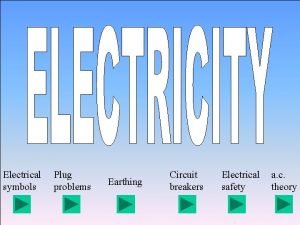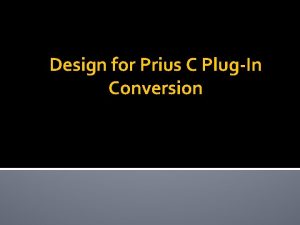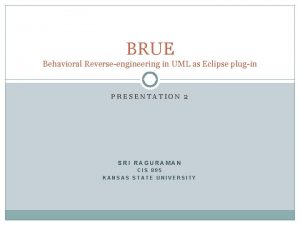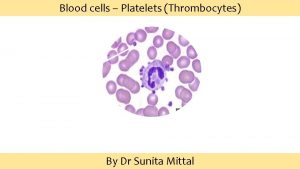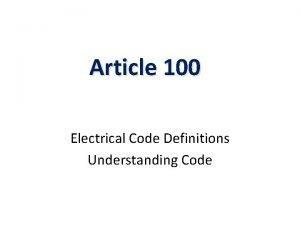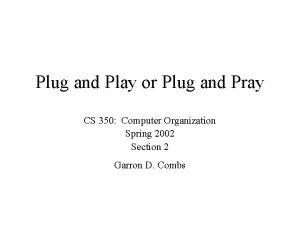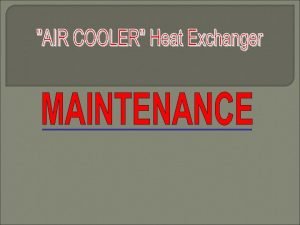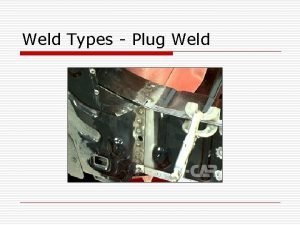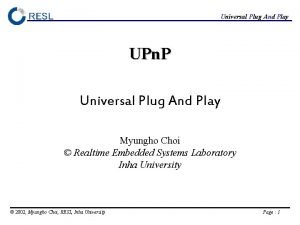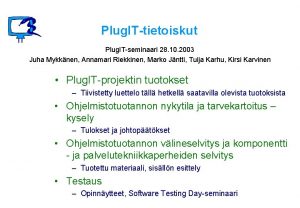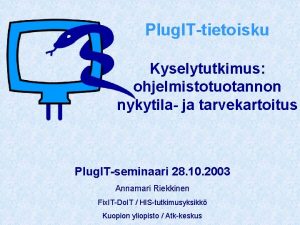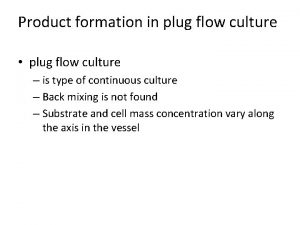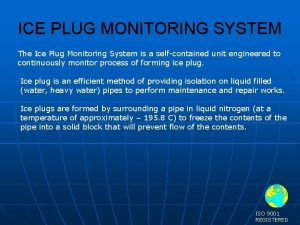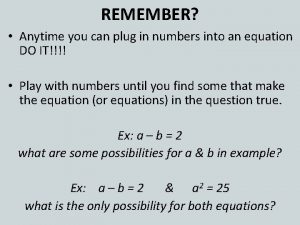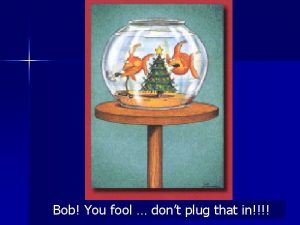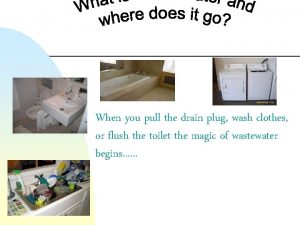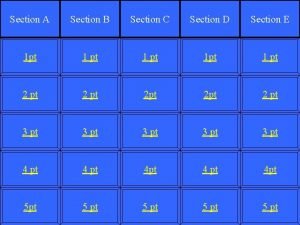Chapter 17 Section 3 If you plug a

























- Slides: 25

Chapter 17 Section 3 • If you plug a string of light bulbs into an electrical outlet the outlet provides a voltage to the circuit. • The voltage makes electrons move through the wire and bulbs from one side of the outlet to the other. • The electric charges in the string of bulbs have a complete path to follow.

What are Circuits • Electrons can move in a loop through the system. • Electric Circuit - A system in which electrons can move in a closed loop • There are two main kinds of electric circuits: • closed circuits and open circuits. • Closed circuit - circuit in which current can flow along a complete path due to a voltage.

What are Circuits • Open Circuit - The path is interrupted or there is no voltage, then no charge can flow through the circuit. • If a bulb is connected to a battery, the inside of the battery is part of the circuit. • Current can flow through the battery. • The source of the voltage is always part of the conducting path of a closed circuit.

USING SWITCHES IN A CIRCUIT • To change a circuit from open to closed, we use a switch. • Switch - a device in a circuit that allows the circuit to be changed from open to closed and back again.

Switches • Many switches work by breaking the path that electrons flow through in a circuit. • For example, a switch may have metal bars on it that can touch part of the wire when the switch is open, the metal bars do not touch the wire. • Electrons cannot flow through the circuit if the bars are not touching the wire. • Then, the circuit is open. When the bars touch the wire, electrons can flow, and the circuit is closed.

How Can You Draw a Circuit? • Complicated circuits can be difficult to describe in words. • Schematic Diagrams – Drawings instead of using words to describe circuits used by scientists. • In a schematic diagram, each part of a circuit is represented by a different symbol • In a schematic diagram, wires and other simple conductors are represented by straight lines and right angles.

RESISTORS • Different materials have different resistances. • Resistors - are devices that are used in circuits to control the amount of current flowing through the circuit. • Each resistor has a specific resistance. • For example, a resistor may be a 10 6 resistor. In schematic diagrams, resistors are shown as bent lines

Light Bulbs • Remember that resistance is what makes light bulbs glow. • Light bulbs are a special kind of resistor. • Therefore, a light bulb is shown as a resistor with a circle around it.

Batteries • Every circuit must have a source of voltage. • In many circuits, this source is a battery. • Batteries are represented by two lines.

Switches • Switches can be represented by two different symbols. • One symbol represents an open switch. • The other represents a closed switch.

What Are Two Ways of Connecting the Components of a Circuit? • Most circuits that we use every day contain more than one component, or part. • For example, a circuit may contain a battery, a light bulb, and a switch. • There are two main ways of connecting these elements in a circuit: in parallel or in series. • The type of connection in a circuit affects how much voltage each component receives.

Series Circuit • Series circuit - The voltage of the battery is divided between the different components in the circuit. • The current must flow through all of the components in order to complete the circuit. • All of the current flows along the same path. • Therefore, the current in each component of a series circuit is the same. • Even though the current is the same, the resistance in each device is different. • That means that the voltage across each device in a series circuit may be different. • You can see a series circuit in the figure below.

Series Circuit • If one device along the path of the series circuit is removed, it will cause a break in the circuit. • The circuit is no longer a closed circuit, so the devices will not work. • For example, if one of the light bulbs in the figure above were removed, the current could not follow a complete path. • Circuit would be open, and the remaining light bulb would not work. • Many different things can stop the current in a series circuit. • An open switch, a burned-out light bulb, or a cut wire may prevent the whole series circuit from working.

Parallel Circuit • Parallel Circuit - the voltage across each part of the circuit is the same. • Current in each device can differ. • The current can follow several different paths through the circuit. • In a parallel circuit, one or more of the devices can be removed and there will still be current in the circuit. • For example, if you were to remove one of the light bulbs in the circuit above, the other light bulb would still light. • Electrons would flow from the battery through the other light bulb.

How Is the Power of a Circuit Determined? • Many appliances and devices that you use every day use electrical energy. • This energy may come from a battery or from a power plant miles away. • The amount of work the device can do depends on how much power it uses. • For example, a 1, 200 W microwave oven can heat food faster than an 800 W microwave oven. (Remember that the watt, W, is the SI unit of power. )

How Is the Power of a Circuit Determined? • As a charge moves in a circuit, the charge loses energy. Some energy turns into useful work. • However, remember that no machine is 100% efficient. The same is true for electronic devices. • As current moves through a circuit, some of the energy is lost to the surroundings as heat. • Electric Power - The rate at which electrical energy is turned into other forms of energy. • Remember that power is the rate at which work is done. This is also true for electric power.

Determining Electric Power • You can calculate electric power by multiplying the current, I, by the voltage difference, V, in a circuit. • The equation below shows this relationship. • power = current x voltage • P = IV

Determining Electric Power • Let’s look at an example of how to use the power equation. A television uses 320 W of power. How much current does the television use when it is plugged into a 120 V outlet?

Determining Electric Power

Power Lost in a Resistor • You can combine the electric power equation with Ohm’s law. • Allows you to calculate the power that is lost when current flows through a resistor. • For example, if voltage difference is constant, you can use the equation below to calculate power loss: • P=I 2 R • One watt (W) is equal to one joule per second (1 J/s). • From the power equation, you can see that one watt is also equal to one volt times one ampere (1 V • A)

Power and Energy • If you have ever seen an electricity bill • You may have noticed that the electric company charges by the kilowatt-hour (k. W • h). • Kilowatt-hours are units of energy. • One kilowatt-hour is equal to 3. 6 × 106 J.

How Do Fuses And Circuit Breakers Work? • If you plug many devices into an electrical outlet, the total resistance of the circuit decreases. • This can increase the current in the circuit. • Overloaded - If the electrical wires carry more current than is safe. • An overloaded circuit can cause fires • If the insulation around an electrical wire is worn, two wires may touch. • This creates another path for current to travel, which is a short circuit. A short circuit can also cause fires.

How Do Fuses And Circuit Breakers Work? • Fuses and circuit breakers, lower the danger in short and overloaded circuits. • A fuse is a ribbon of wire with a low melting point. When the current in a circuit reaches a certain temperature, the fuse melts, or blows. • This opens the circuit and the current stops • For example, a 20 A fuse will melt if the current in the circuit is more than 20 A. A blown fuse is a sign that a short circuit or a circuit overload is present. • Once a fuse has blown, it must be replaced before the circuit will function. The image below shows examples of a normal fuse and a blown fuse.

How Do Fuses And Circuit Breakers Work? • Many homes have circuit breakers instead of fuses. • A circuit breaker acts like a switch. • It opens when there is a current overload. • If you fix the circuit so there is no overload, you can reset the switch in the circuit breaker. • Then, the circuit will work again. • Ground fault circuit interrupter (GFCI) - special kind of electrical outlet. It acts like a small circuit breaker. • GFCI outlets may be found where water is used near electricity, such as in bathrooms and kitchens.

 If you plug an electric toaster rated at 110v
If you plug an electric toaster rated at 110v 2 pin plug
2 pin plug Single bevel welding
Single bevel welding Weld types and symbols
Weld types and symbols Tools needed in making simple electrical gadgets
Tools needed in making simple electrical gadgets Doc plug-ins in gsdl wikipedia
Doc plug-ins in gsdl wikipedia Wet plug socket
Wet plug socket Radio plug script
Radio plug script Vasoconstriction
Vasoconstriction Process of platelet plug formation
Process of platelet plug formation Live neutral earth symbols
Live neutral earth symbols Converting prius to plug in
Converting prius to plug in Objective of gas welding
Objective of gas welding Brue plug
Brue plug Uml diagram eclipse plugin
Uml diagram eclipse plugin Composition of platelets
Composition of platelets Lemešni plug
Lemešni plug Nec article 100 definitions
Nec article 100 definitions Bot plug
Bot plug Plug flow reactor animation
Plug flow reactor animation What's a plug and play
What's a plug and play Broken heat exchanger
Broken heat exchanger Vandex
Vandex Filtermat spray dryer
Filtermat spray dryer Plug and play fan
Plug and play fan Hot plug pcie
Hot plug pcie
